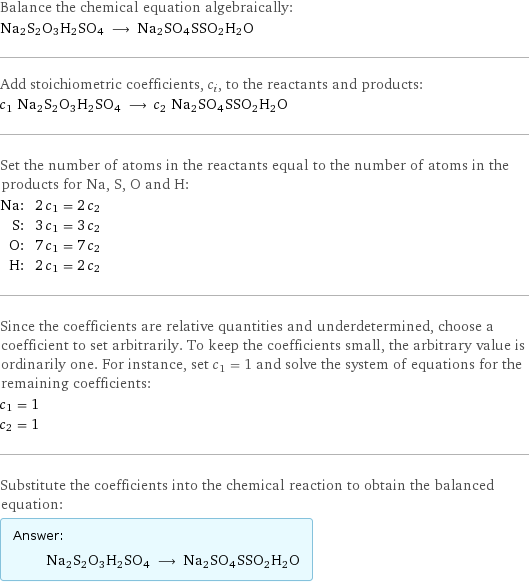Input interpretation

Na2S2O3H2SO4 ⟶ Na2SO4SSO2H2O
Balanced equation

Balance the chemical equation algebraically: Na2S2O3H2SO4 ⟶ Na2SO4SSO2H2O Add stoichiometric coefficients, c_i, to the reactants and products: c_1 Na2S2O3H2SO4 ⟶ c_2 Na2SO4SSO2H2O Set the number of atoms in the reactants equal to the number of atoms in the products for Na, S, O and H: Na: | 2 c_1 = 2 c_2 S: | 3 c_1 = 3 c_2 O: | 7 c_1 = 7 c_2 H: | 2 c_1 = 2 c_2 Since the coefficients are relative quantities and underdetermined, choose a coefficient to set arbitrarily. To keep the coefficients small, the arbitrary value is ordinarily one. For instance, set c_1 = 1 and solve the system of equations for the remaining coefficients: c_1 = 1 c_2 = 1 Substitute the coefficients into the chemical reaction to obtain the balanced equation: Answer: | | Na2S2O3H2SO4 ⟶ Na2SO4SSO2H2O
Structures

Na2S2O3H2SO4 ⟶ Na2SO4SSO2H2O
Names

Na2S2O3H2SO4 ⟶ Na2SO4SSO2H2O
Equilibrium constant
![Construct the equilibrium constant, K, expression for: Na2S2O3H2SO4 ⟶ Na2SO4SSO2H2O Plan: • Balance the chemical equation. • Determine the stoichiometric numbers. • Assemble the activity expression for each chemical species. • Use the activity expressions to build the equilibrium constant expression. Write the balanced chemical equation: Na2S2O3H2SO4 ⟶ Na2SO4SSO2H2O Assign stoichiometric numbers, ν_i, using the stoichiometric coefficients, c_i, from the balanced chemical equation in the following manner: ν_i = -c_i for reactants and ν_i = c_i for products: chemical species | c_i | ν_i Na2S2O3H2SO4 | 1 | -1 Na2SO4SSO2H2O | 1 | 1 Assemble the activity expressions accounting for the state of matter and ν_i: chemical species | c_i | ν_i | activity expression Na2S2O3H2SO4 | 1 | -1 | ([Na2S2O3H2SO4])^(-1) Na2SO4SSO2H2O | 1 | 1 | [Na2SO4SSO2H2O] The equilibrium constant symbol in the concentration basis is: K_c Mulitply the activity expressions to arrive at the K_c expression: Answer: | | K_c = ([Na2S2O3H2SO4])^(-1) [Na2SO4SSO2H2O] = ([Na2SO4SSO2H2O])/([Na2S2O3H2SO4])](../image_source/94f3b82e7016c2536303affdc5c61b43.png)
Construct the equilibrium constant, K, expression for: Na2S2O3H2SO4 ⟶ Na2SO4SSO2H2O Plan: • Balance the chemical equation. • Determine the stoichiometric numbers. • Assemble the activity expression for each chemical species. • Use the activity expressions to build the equilibrium constant expression. Write the balanced chemical equation: Na2S2O3H2SO4 ⟶ Na2SO4SSO2H2O Assign stoichiometric numbers, ν_i, using the stoichiometric coefficients, c_i, from the balanced chemical equation in the following manner: ν_i = -c_i for reactants and ν_i = c_i for products: chemical species | c_i | ν_i Na2S2O3H2SO4 | 1 | -1 Na2SO4SSO2H2O | 1 | 1 Assemble the activity expressions accounting for the state of matter and ν_i: chemical species | c_i | ν_i | activity expression Na2S2O3H2SO4 | 1 | -1 | ([Na2S2O3H2SO4])^(-1) Na2SO4SSO2H2O | 1 | 1 | [Na2SO4SSO2H2O] The equilibrium constant symbol in the concentration basis is: K_c Mulitply the activity expressions to arrive at the K_c expression: Answer: | | K_c = ([Na2S2O3H2SO4])^(-1) [Na2SO4SSO2H2O] = ([Na2SO4SSO2H2O])/([Na2S2O3H2SO4])
Rate of reaction
![Construct the rate of reaction expression for: Na2S2O3H2SO4 ⟶ Na2SO4SSO2H2O Plan: • Balance the chemical equation. • Determine the stoichiometric numbers. • Assemble the rate term for each chemical species. • Write the rate of reaction expression. Write the balanced chemical equation: Na2S2O3H2SO4 ⟶ Na2SO4SSO2H2O Assign stoichiometric numbers, ν_i, using the stoichiometric coefficients, c_i, from the balanced chemical equation in the following manner: ν_i = -c_i for reactants and ν_i = c_i for products: chemical species | c_i | ν_i Na2S2O3H2SO4 | 1 | -1 Na2SO4SSO2H2O | 1 | 1 The rate term for each chemical species, B_i, is 1/ν_i(Δ[B_i])/(Δt) where [B_i] is the amount concentration and t is time: chemical species | c_i | ν_i | rate term Na2S2O3H2SO4 | 1 | -1 | -(Δ[Na2S2O3H2SO4])/(Δt) Na2SO4SSO2H2O | 1 | 1 | (Δ[Na2SO4SSO2H2O])/(Δt) (for infinitesimal rate of change, replace Δ with d) Set the rate terms equal to each other to arrive at the rate expression: Answer: | | rate = -(Δ[Na2S2O3H2SO4])/(Δt) = (Δ[Na2SO4SSO2H2O])/(Δt) (assuming constant volume and no accumulation of intermediates or side products)](../image_source/81394b005104eca670851a201bd48a3e.png)
Construct the rate of reaction expression for: Na2S2O3H2SO4 ⟶ Na2SO4SSO2H2O Plan: • Balance the chemical equation. • Determine the stoichiometric numbers. • Assemble the rate term for each chemical species. • Write the rate of reaction expression. Write the balanced chemical equation: Na2S2O3H2SO4 ⟶ Na2SO4SSO2H2O Assign stoichiometric numbers, ν_i, using the stoichiometric coefficients, c_i, from the balanced chemical equation in the following manner: ν_i = -c_i for reactants and ν_i = c_i for products: chemical species | c_i | ν_i Na2S2O3H2SO4 | 1 | -1 Na2SO4SSO2H2O | 1 | 1 The rate term for each chemical species, B_i, is 1/ν_i(Δ[B_i])/(Δt) where [B_i] is the amount concentration and t is time: chemical species | c_i | ν_i | rate term Na2S2O3H2SO4 | 1 | -1 | -(Δ[Na2S2O3H2SO4])/(Δt) Na2SO4SSO2H2O | 1 | 1 | (Δ[Na2SO4SSO2H2O])/(Δt) (for infinitesimal rate of change, replace Δ with d) Set the rate terms equal to each other to arrive at the rate expression: Answer: | | rate = -(Δ[Na2S2O3H2SO4])/(Δt) = (Δ[Na2SO4SSO2H2O])/(Δt) (assuming constant volume and no accumulation of intermediates or side products)
Chemical names and formulas

| Na2S2O3H2SO4 | Na2SO4SSO2H2O formula | Na2S2O3H2SO4 | Na2SO4SSO2H2O Hill formula | H2Na2O7S3 | H2Na2O7S3
Substance properties

| Na2S2O3H2SO4 | Na2SO4SSO2H2O molar mass | 256.2 g/mol | 256.2 g/mol
Units
